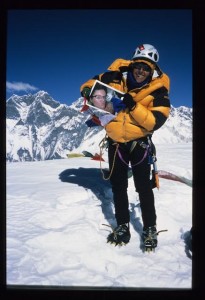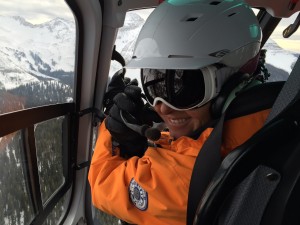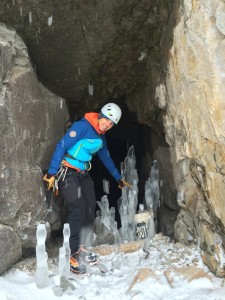AMGA PARTNER ATHLETE PROFILE: ANGELA HAWSE, WITH MARMOT, DYNAFIT, STERLING ROPE, JULBO, AND SCARPA
The AMGA is excited to announce a blog series, running through 2015, featuring Q & As with AMGA guides, instructors, and members who are integral members of our corporate sponsors’ athlete teams—men and women who are delivering both in the guiding world and as ambassadors for their brands and chosen outdoor sport(s). There is and always has been much overlap between mountain guides and top mountain athletes: guiding and teaching are a natural fit for those who excel in skiing, rock climbing, ice climbing, and mountaineering, as the activities pull from the same passion, wisdom, and skill set.
This week’s mini-profile is of IFMGA/AMGA and AMGA Rock, Alpine, and Ski Guide Angela Hawse, an athlete for our partners Marmot, Dynafit, Sterling Rope, Julbo, and Scarpa.

Angela Hawse, IFMGA/AMGA guide and an athlete for AMGA partners Marmot and Dynafit. Photo: Angela Hawse Collection
How did you get into climbing, and then guiding?
As a child, I was always climbing as high as I could in trees. I was turned on to rock climbing in college by a friend who took me out a bunch, then I took a 3-week rock-climbing course in which we were leading, sans cams, after the first week and pointed to multipitch climbs from 5.5 to 5.8 by week three. I was inspired by my instructors and wanted to be just like them. My first real guiding job was working for Outward Bound as an assistant instructor for $39 a day in 1984. I knew I had made the big time and have never looked back.
Why do you love guiding?
I’m addicted to it. I feel more at home in the mountains than anywhere, and love nature. I love moving over terrain and the full engagement of mind and body with gravity and the elements. I thrive on thinking on my feet and problem-solving with each situation being completely unique but familiar at the same time. I love the technical aspects of guiding, using the rope or nuances of communication as means of control. I am a control freak, so guiding suits me well. I love people and am genuinely curious about what makes others tick. Getting people out of their comfort zones and pushing them past what they think (but I know) is possible I find incredibly rewarding. Guiding is not just a job; it’s lifestyle that has provided me with a community that I love, challenges I need, and memories I treasure. The places it takes me are priceless. I don’t think anything could make me happier than what I do.
Why is standardized guide education important, especially now?
I cringe a bit at the word “standardized” but I am a huge advocate of the value of education, training, and certification. Experience does matter, and no guide is complete without a solid baseline of time in terrain. Our country was built by pioneers, and that spirit carried over in shaping the profession of guiding in the United States. To this day, anyone can hang a shingle and call themselves a mountain guide in our country. It’s crazy that a plumber should have to go through a specialized licensing process to make a living, but a guide who has others’ lives in their hands is not held to a standard of training. That will change. Arguably, the services of guides and instructors aren’t necessarily “needed or required” by the the public. But undeniably, skiing, climbing, and adventure in general have become mainstream, and there is increasing demand for our work. The outdoor industry has shown huge support for guide education. Media coverage of guides has increased, and that furthers our cause. Guide services have done their part for decades training guides internally for the specifics of the job. But all combined, there is nothing that can replace training and assessment by a third party that upholds internationally accepted standards. Guide education provides a common platform of accepted practices for the specifics of the terrain in which we operate. When we fully embrace the Scope of Practice in the US and uphold ourselves to it, we will raise our profession to a higher standard of care across the board for our clients and ourselves.
What is in your pack on a typical day of guiding?
It’s completely dependent on the discipline, but the fattest kit I ever carry for day tripping is for heli-ski guiding. More often than not I wear an avalanche airbag. Inside goes ear protection, Julbo goggles and sunglasses, first-aid kit, iPhone/camera, radio, satellite phone, Casio altimeter watch, leatherman, small repair kit, headlamp, probe, shovel, snow saw (doubles as a wood saw), small foam pad, fire starter and lighter, ski scraper, water and small thermos, extra food, compass, topo map (in addition to smartphone), flagging and chalk, 3 AAA batteries, hand warmers, climbing skins, and a few spares for clients that include sunglasses, large mittens, Marmot Ama Dablam puffy, and a warm hat.
What has been your best day out guiding, and why?
Summiting Ama Dablam on the “Mamas Dablam” Expedition. This was a two-year project that several Chicks with Picks alumni asked me to put together. They wanted to do something that was within their abilities but would challenge them; they wanted to train hard for it and they wanted to raise money for a local cause as part of the effort. It was a bittersweet trip that showcased the massive team effort involved to put someone on the summit, Himalayan-style. Only myself and one client reached the summit, but when we stood on top I truly felt the spirit and effort of the entire team with us. We climbed entirely self-supported and hired only Sherpanis for our support to basecamp—truly an all-women trip. We raised $23,000 for the dZi Foundation that helped start a safehouse for girls in the region. Topping it all off by reaching the summit was one of the greatest feelings of accomplishment I’ve ever felt and I’m still super proud of our effort.
What has been your worst/funniest/most comedy-of-errors day out guiding, and why?
This has to be the trip I guided to Carstensz Pyramid that was ill-fated from the onset, with logistical woes, delays, deception, and Stone Age locals. Short of the long of it… I was hired to guide two back-to-back trips at a 4:1 ratio (I had a different plan for the climb—guide it 2:1). Had it all turned out well I would have climbed the mountain four times. As it so turned out, only one client made it to basecamp (helicopter and weather woes). I never saw the other five clients again, but was assured that they survived the Stone Age village where I left them, and eventually returned to their respective countries. Two of the first group never made it to the island (Papua) the mountain was on. Two of the first group decided to stay and come in with the second group, which left me with a 6:1 ratio. The comedy of it all was I got to guide the mountain 1:1. All combined, I experienced the wildest 24-hour four-wheel drive approach I’ve ever had in my life (crossing class 2–3 rivers and a forced bivouac with clients), penis-sheathed tribesmen threatening my guests with sticks and stones, singed bats and odd vegetables for sale at the market, and house arrest while waiting out weather to keep us safe from the locals. To the guide service’s credit, they refunded every client who did not make it to basecamp!
What is the one, most essential trick you’ve learned to make you a more efficient guide or climber?
Plan ahead and have a secret weapon. I can’t share it with you or it wouldn’t be a secret!
What is the one item you can’t live without?
My passport.
How do you let loose/relax when you’re not working?
I’m working on that. Mountain biking, climbing, skiing and photography.
What are the top three songs on your playlist?
Live Your Life – T.I.
Take California – Propellerheads
Royals – Lorde














